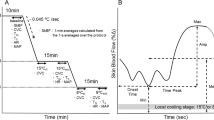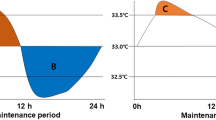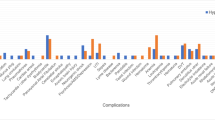Abstract
We have investigated the effects of mild whole body hypothermia on the amplitude and latency of somatosensory evoked potentials (SEPs) in control subjects (n = 12) and patients (n = 15) with chronic compressive or contusive spinal cord injury (SCI). Mild hypothermia (—1°C) was induced by controlled circulation of propylene glycol through a 'microclimate' head and vest garment while reductions in oral and limb temperatures were monitored. Cooling induced a delayed onset and reduced amplitude of tibial nerve SEPs in control subjects. All SCI patients with recordable SEPs (n = 11) showed similarly delayed onset of the cortical response. In contrast to the controls, nine of the 11 SCI patients showed an increase in amplitude of cortical SEPs. In three of these patients the increase in amplitude exceeded 100% of the precooling values. The cooling-induced changes in SEP amplitude and latency reversed on rewarming for both groups. The cooling-induced increases in cortical SEP amplitude support the a priori hypothesis that cooling would enhance central conduction in some SCI patients with conduction deficits due to focal demyelination.
Similar content being viewed by others
Article PDF
References
McDonald W I (1975) Mechanisms of functional loss and recovery in spinal cord damage: In: Ciba Foundation Symposium 34 (new series), Symposium on the Outcome of Severe Damage to the Central Nervous System. Elsevier, Amsterdam: 23–33.
Wakefield C L, Eidelberg E (1975) Electron microscopic observations of the delayed effects of spinal cord compression. Exp Neurol 48: 637–646.
Yeo J D (1976) A review of experimental research in spinal cord injury. Paraplegia 14: 1–11.
Young W, Yen V, Blight A (1982) Extracellular calcium ionic activity in experimental spinal cord contusion. Brain Research 253: 105–113.
Dimitrijevic M R (1988) Residual motor functions in spinal cord injury. In: Waxman SE, editor. Advances in Neurology 47. Functional Recovery in Neurological Disease. Raven Press. NY.
Blight A R (1983) Cellular morphology of chronic spinal cord injury in the cat: Analysis of myelinated axons by line-sampling. Neuroscience 10(2): 521–543.
Blight A R (1983) Axonal physiology of chronic spinal cord injury in the cat: Intracellular recording in vitro. Neuroscience 10: 1471–1486.
Blight A R (1985) Delayed demyelination and macrophage invasion: A candidate for secondary cell damage in spinal cord injury. Cent Nerv Syst Trauma 2: 299–314.
Blight A R, Young W (1989) Central axons in injured cat spinal cord recover electrophysiological function following remyelination by Schwann cells. J Neurol Sci 91: 15–34.
Gledhill R F, Harrison B M, McDonald W I (1973) Demyelination and remyelination after acute spinal cord compression. Exp Neurol 38: 472–487.
McDonald W I (1974) Remyelination in relation to clinical lesions of the central nervous system. Br Med Bull 30: 186–189.
Harrison B M, McDonald W I (1977) Remyelination after transient experimental compression of the spinal cord. Ann Neurol 1: 542–551.
Gledhill R F, McDonald W I (1977) Morphological characteristics of central demyelination and remyelination. A single fiber study. Ann Neurol 1: 552–560.
Bunge R P, Puckett W R, Becerra J L, Marcillo A, Quencer R M (1993) Observations on the pathology of human spinal cord injury: A review and classification of 22 new cases with details from a case of chronic cord compression with extensive focal demyelination, In: Seil FJ, editor. Neural Regeneration 59. Raven Press, NY: 75–89.
Chiu S Y, Ritchie J M (1980) Potassium channels in nodal and internodal axonal membrane in mammalian myelinated fibres. Nature 284: 170–171.
Chiu S Y, Ritchie J M (1981) Evidence for the presence of potassium channels in the internodal region of acutely demyelinated mammalian single nerve fibres. J Physiol (Lond) 313: 415–437.
Koles Z J, Rasminsky M (1972) A computer simulation of conduction in demyelinated nerve fibres. J Physiol (Lond) 227: 351–364.
McDonald W I, Sears T A (1970) The effect of experimental demyelination on conduction in the central nervous system. Brain 93: 583–598.
Sakatani K, Ohta T, Shimo-oku M (1987) Conductivity of dorsal column fibers during experimental spinal cord compression and after decompression at various stimulus frequencies. Cent Nerv Syst Trauma 4: 161–179.
Sakatani K, Iizuka H, Young W (1991) Randomized double pulse stimulation for assessing stimulus frequency-dependent conduction in injured spinal and peripheral axons. EEG Clin Neurophysiol 81: 108–117.
Waxman S G (1988) Biophysical mechanisms of impulse conduction in demyelinated axons. In: Waxman SG, editor. Functional Recovery in Neurological Disease. Raven Press, New York: 185–214.
Waxman S G (1989) Demyelination in spinal cord injury. J Neurol Sci 91: 1–14.
Blight A R (1989) Effect of 4-Aminopyridine on axonal conduction-block in chronic spinal cord injury. Brain Res Bull 22: 47–52.
Davis F A, Jacobson S (1971) Altered thermal sensitivity in injured and demyelinated nerve: A possible model of temperature effects in multiple sclerosis. J Neurol Neurosurg Psychiatry 34: 551–561.
Brismar T (1980) Potential clamp analysis of membrane currents in rat myelinated nerve fibres. J Physiol (Lond) 298: 171–184.
Davis F A (1970) Axonal conduction studies based on some considerations of temperature effects in multiple sclerosis. EEG Clin Neurophysiol 28: 281–286.
Frankenhaeuser B, Moor L E (1963) The effect of temperature on the sodium and potassium permeability changes in myelinated nerve fibres of Xenopus laevis. J Physiol (Lond) 169: 431–437.
Louis A A, Hotson J R (1986) Regional cooling of human nerve and slowed NA+ inactivation. EEG Clin Neurophysiol 63: 371–375.
Schauf C L, Davis F A (1974) Impulse conduction in multiple sclerosis: a theoretical basis for modification by temperature and pharmacological agents. J Neurol Neurosurg Psychiatry 37: 152–161.
Rasminsky M (1973) The effects of temperature on conduction in demyelinated single nerve fibres. Arch Neurol 28: 287–292.
Watson C W (1959) Effect of lowering of body temperature on the symptoms and signs of multiple sclerosis. N Engl J Med 261: 1253–1259.
VanDieman H A M, VanDongen M M M M, Dammers J W H H, Polman C H (1992) Increased visual impairment after exercise (Uhthoff's phenomenon) in multiple sclerosis: Therapeutic possibilities. Eur Neurol 32: 231–234.
Boynton B L, Garramone P M, Buca J (1985) Observations on the effects of cool baths for patients with multiple sclerosis. Phys Ther Rev 39: 297–299.
Symington G R, MacKay I R, Currie T T (1977) Improvement in multiple sclerosis during prolonged induced hypothermia. Neurology 27: 302–303.
Nelson D A, McDowell E (1959) The effects of induced hyperthermia on patients with multiple sclerosis. J Neurol Neurosurg Psychiatry 11: 113–116.
Namerow N S (1968) Circadian temperature rhythm and vision in multiple sclerosis. Neurology 18: 417–422.
Hayes K C, Blight A R, Potter P J, Allatt R D, Hsieh J T C, Wolfe D L et al (1993) Preclinical trial of 4-Aminopyridine in patients with chronic spinal cord injury. Paraplegia 31: 216–224.
Cooper K E, Cranston W I, Snell E S (1964) Temperature in the external auditory meatus as an index of central temperature changes. J Appl Physiol 19: 1032–1035.
Chiappa K H, editor (1990) Evoked Potentials in Clinical Medicine. Raven Press, New York.
Blair E (1964) Clinical Hypothermia. McGraw-Hill, New York.
DeLisa J, Mackenzie K, Baran E (1987) Manual of Nerve Conduction Velocity and Somatosensory Evoked Potentials. 2nd ed. Raven Press, New York: 190–200.
Hume A L, Durkin M A (1986) Central and spinal somatosensory conduction times during hypothermic cardiopulmonary bypass and some observations on the effects of fentanyl and isoflurane anesthesia. EEG Clin Neurophysiol 65: 46–58.
De Jesus P V, Hausmanowa-Petrusewicz I, Barchi R L (1973) The effect of cold on nerve conduction of human slow and fast nerve fibers. Neurology 23: 1182–1189.
de Jong R H, Hershey W N, Wagman I H (1966) Nerve conduction velocity during hypothermia in man. Anesthesiology 27: 805–810.
Benita M, Conde H (1972) Effects of local cooling upon conduction and synaptic transmission. Brain Res 36: 133–151.
Stejskal L, Travnicek V, Sourek K, Kredba J (1980) Somatosensory evoked potentials in deep hypothermia. Appl Neurophysiol 43: 1–7.
Markand O N, Warren C H, Moorthy S S, Stoelting R K, King R D (1984) Monitoring of multimodality evoked potentials during open heart surgery under hypothermia. EEG Clin Neurophysiol 59: 432–440.
Budnick B, McKeown K L, Wiederholt W C (1981) Hypothermia-induced changes in rat short latency somatosensory evoked potentials. EEG Clin Neurophysiol 51: 19–31.
Oro J, Haghighi S (1992) Effects of altering core body temperature on somatosensory and motor evoked potentials in rats. Spine 17: 498–503.
Perot P L (1973) The clinical use of somatosensory evoked potentials in spinal cord injury. Clin Neurosurg 20: 367–381.
Riffel B . Stohr M, Korner S (1984) Spinal and cortical evoked potentials following stimulation of the posterior tibial nerve in the diagnosis and localisation of spinal cord diseases. EEG Clin Neurophysiol 58: 400–407.
Young W (1982) Correlation of somatosensory evoked potentials and neurological findings in spinal cord injury In: Tator CD, editor. Early Management of Acute Spinal Cord Injury. Raven Press, New York.
Simons D J (1937) Note on effect of heat and of cold upon certain symptoms of multiple sclerosis. Bull Neurol Inst 6: 385–386.
Guthrie T C (1951) Visual and motor changes in patients with multiple sclerosis: A result of induced changes in environmental temperature. Arch Neurol Psychiatry 65: 437–451.
Bajada S, Mastaglia F L, Black J L, Collins D W K (1980) Effects of induced hyperthermia on visual evoked potentials and saccade parameters in normal subjects and multiple sclerosis patients. J Neurol Neurosurg Psychiatry 43: 849–852.
Matthews W B, Read D J, Pountney E (1979) Effect of raising body temperature on visual and somatosensory evoked potentials in patients with multiple sclerosis. J Neurol Neurosurg Psychiatry 42: 250–255.
Author information
Authors and Affiliations
Rights and permissions
About this article
Cite this article
Hayes, K., Hsieh, J., Potter, P. et al. Effects of induced hypothermia on somatosensory evoked potentials in patients with chronic spinal cord injury. Spinal Cord 31, 730–741 (1993). https://doi.org/10.1038/sc.1993.115
Issue date:
DOI: https://doi.org/10.1038/sc.1993.115



